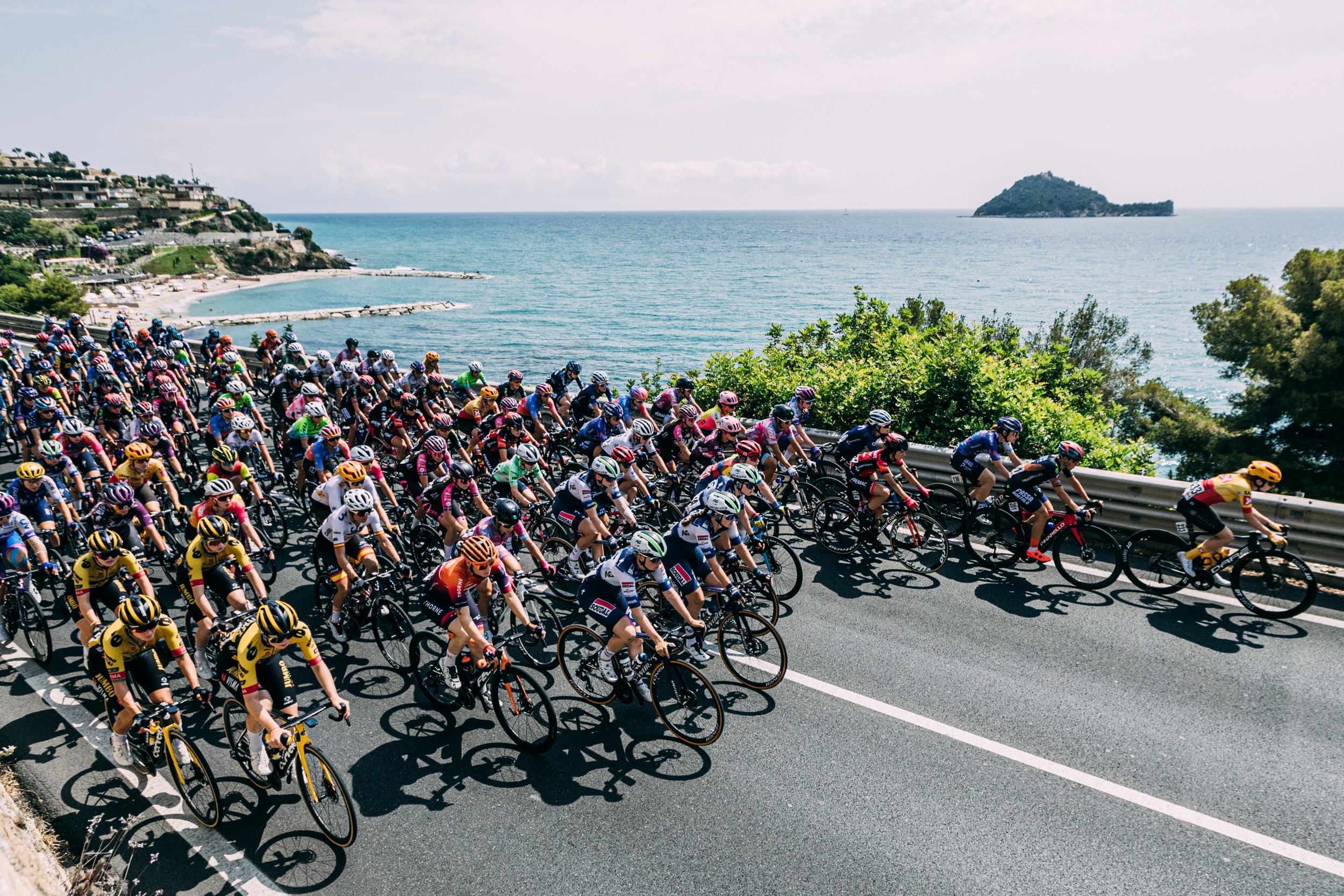

The Giro d’Italia Women enters a new era. With the renowned cycling event organizer RCS taking over, the Women’s Tour of Italy is now under the same management structure as the men’s race. Formerly known as Giro d’Italia Femminile and Giro Donne, the race is now renamed Giro d’Italia Women.
This year’s Giro d’Italia Women will kick off with its Grande Partenza in the Lombardian city of Brescia, located between Lake Garda and Lake Iseo, on Sunday, July 7th. After eight stages, the race will conclude in L’Aquila on July 14th. On the day the French celebrate Bastille Day, the Italians will welcome the Women’s Giro peloton in the capital of the Abruzzo region, nestled in the Apennines.
Race History
The inaugural Giro d’Italia Femminile dates back to 1988, when double silver medalist at the World Championships and two-time Tour de France Feminine winner Maria Canins took home the first-ever Maglia Rosa. In the early years, Italian riders dominated on home soil, led by Fabiana Luperini. Lovingly nicknamed “Pantanina,” Luperini won the overall classification five times between 1995 and 2008. Since Marianne Vos’s first overall victory in 2011, the Giro has become a predominantly Dutch affair. Vos herself won the classification three times, while Anna van der Breggen, who recently announced her comeback, and Annemiek van Vleuten each claimed four victories.
What happened last year
Last year’s Giro d’Italia Donne was a highlight of Annemiek van Vleuten’s impressive farewell tour. The Dutch world champion dominated the race from start to finish, although the Grande Partenza in Chianciano was canceled due to bad weather. Van Vleuten won the second (effectively the first) stage with an 18-kilometer solo breakaway, claimed the pink jersey, and never let it go. Along the way, she also won the sixth and seventh stages. Other highlights included Elisa Longo Borghini’s stage win in her home race, wearing the national champion’s tricolor, and the breakthrough performance of Antonia Niedermaier, who impressively won the fifth stage to Ceres. However, a nasty fall the following day dashed her hopes for the overall classification.
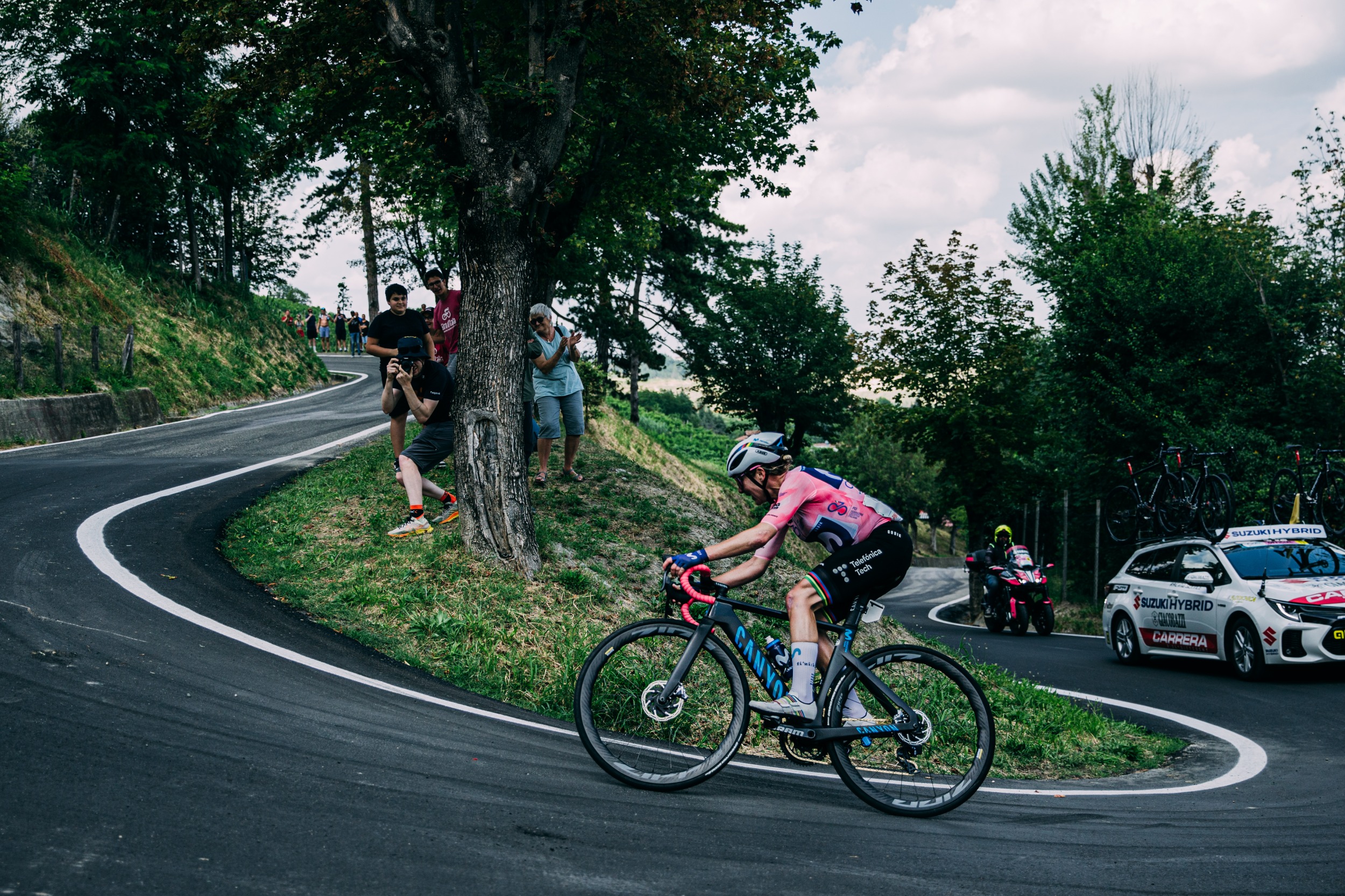
2024 Edition
Eight stages (one less than last year) separate the riders from the start in Brescia to the finish in L’Aquila. A quick glance at the route suggests a gradually increasing difficulty, starting with a time trial, followed by four midweek stages in the hills, and concluding with a final week in the mountains.
Stage 1
Brescia – Brescia (Individual Time Trial): 15.7 km
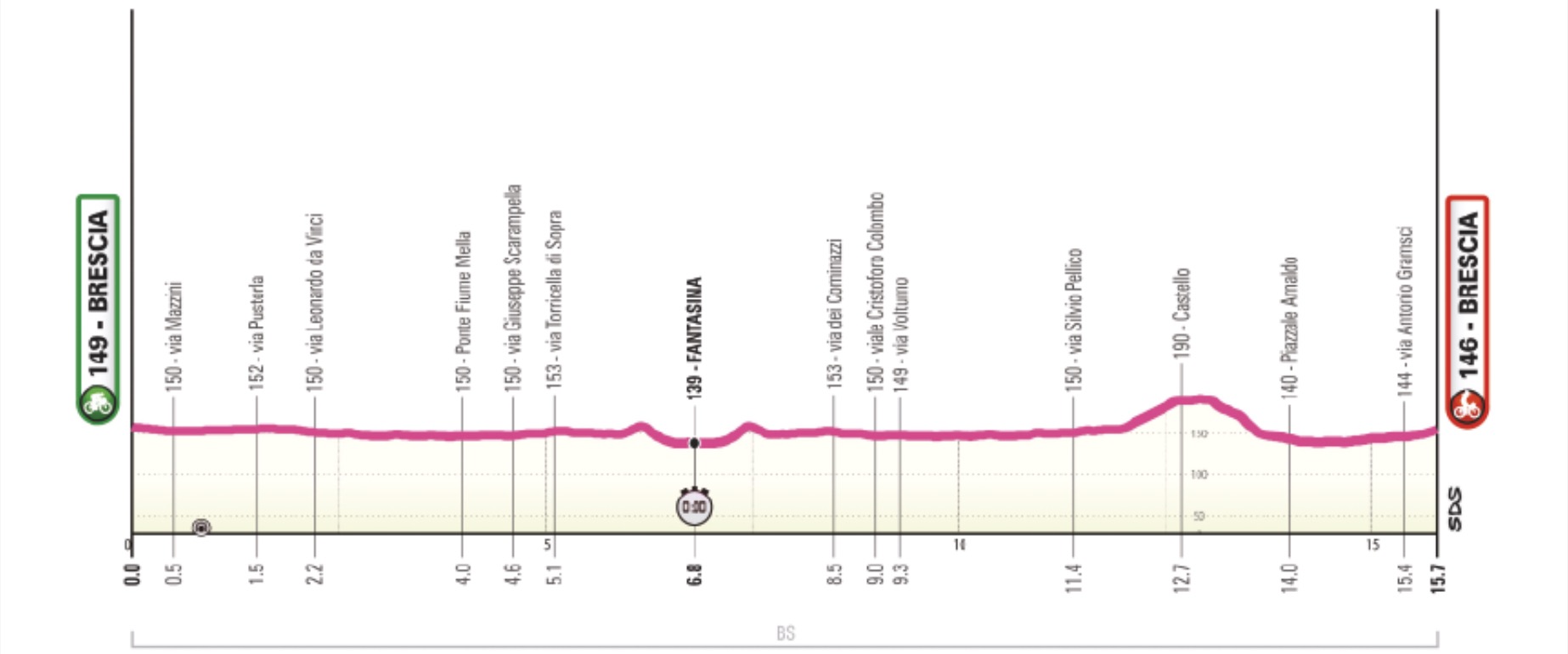
The race kicks off on July 7th in Brescia with a relatively flat time trial spanning 15.7 kilometers. It’s been a while since the last flat time trial in the Giro: in 2017, Van Vleuten bested Van der Breggen and Longo Borghini in a 12.73-kilometer time trial. Since then, most time trials have been uphill, where Van Vleuten and Van der Breggen excelled.
The starting podium is set up at the Piazza della Loggia in the heart of the city, home to 1.2 million residents. The riders will leave the city, heading towards Fantasia for an intermediate time check, before returning to Brescia on the opposite side of the road. The finish line is located at the Piazza del Mercato.
Apart from the bends on the not-too-difficult climb to the Castle of Brescia (just under a kilometer at just below 5%), the time trial is fairly straightforward. It seems to be terrain suited for true power riders who will have to compete with those aiming to lay the groundwork for a strong overall classification.
Stage 2
Sirmione – Volta Mantovana: 110 km
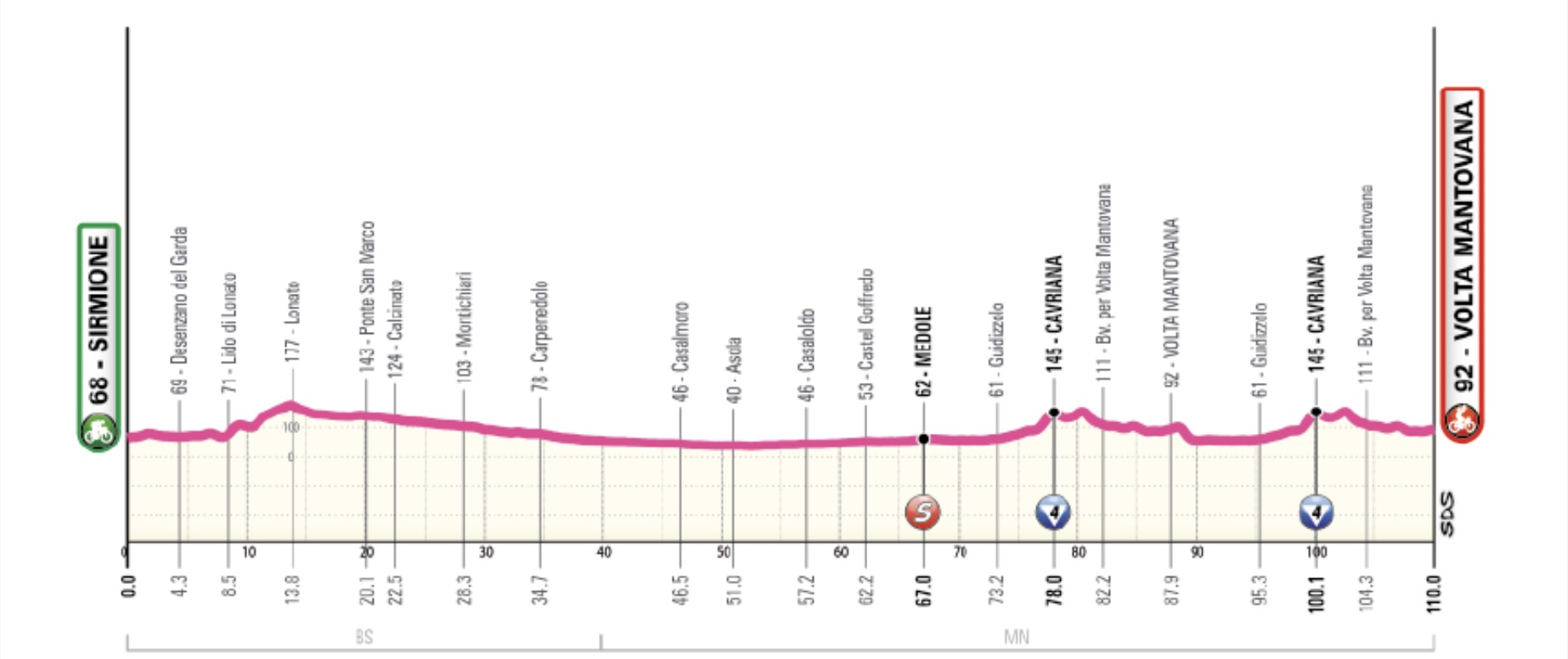
The second stage starts on the shores of Lake Garda in Sirmione. After riding the initial kilometers along the lake, there might be a chance for breakaway riders to gain an advantage on the first ascending meters of the day towards Lonato del Garda.
If they fail, the action will wait until the two final circuits around the finish town of Volta Mantovana. These loops traverse undulating terrain, with the main obstacle being the first categorized climb of the Giro: the Cavriana. Here, the battle will ensue for the first blue jersey, awarded to the leader of the mountains classification.
Whether the finale is challenging enough to keep hungry sprinters from claiming the day’s victory remains to be seen. Opportunities for pure sprinters are scarce, so teams with sprint ambitions will do everything they can to ensure a mass sprint in Volta Mantovana.
Stage 3
Sabbioneta – Toano: 113 km
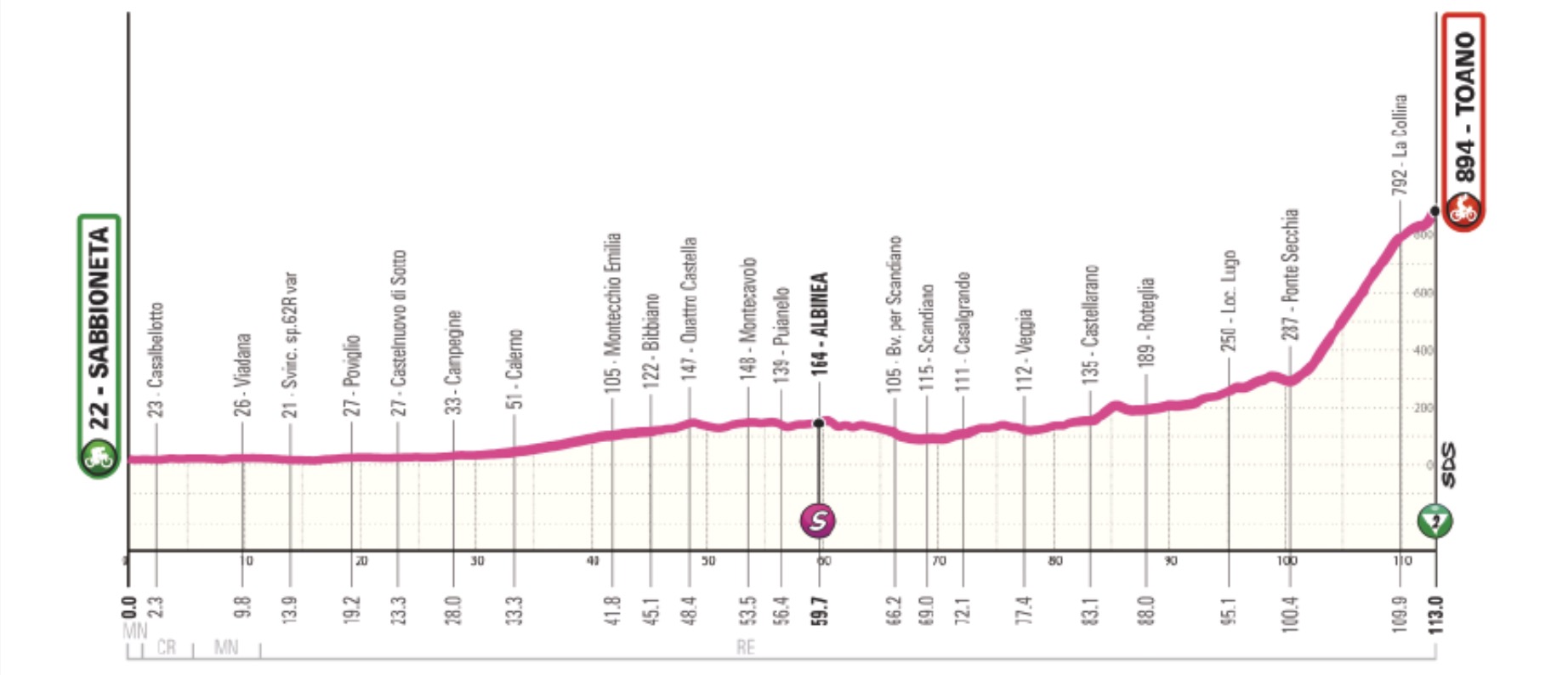
A sprint is certainly not on the agenda for day three. The route starts flat from Sabbioneta, but once the riders catch the scent of Reggio Emilia, the Apennines will loom on the horizon. This is where the stage will be decided, as all roads lead upwards from the small Ponte Secchio. The finish line in Toano is set at an elevation of 894 meters above sea level, following a 12.5-kilometer climb with an average gradient of 4.9%. However, the roads start to incline gently 20 kilometers before the climb.
Is the climb steep enough to create significant time gaps in the general classification? The expectation is yes. However, the peloton might allow a breakaway to contest the stage win. Another key point: from 1,300 meters before the finish, there is a short descent of 300 meters. The road then begins to rise again from the red kite, leading into a steep final kilometer with gradients exceeding 10%.
Stage 4
Imola – Urbino: 134 km
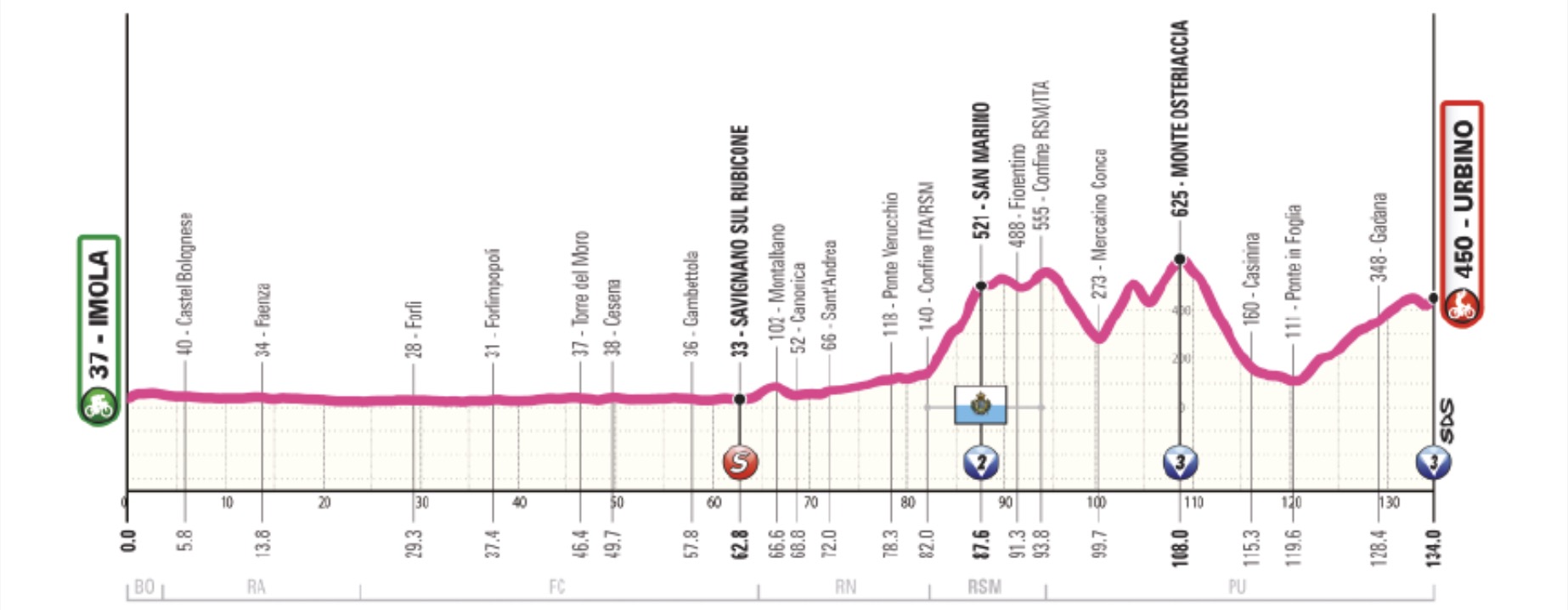
The Tour de France peloton thundered over the Imola race circuit in its third stage. In the fourth stage of the Giro Women, the famous circuit, after starting in the center of Imola, will be the highlight of the opening phase as the race heads towards Urbino. Like the third stage, the beginning is flat, but the finale is much more challenging.
After the race circuit, the peloton heads straight and over flat roads towards the seaside town of Rimini, but won’t quite reach the Adriatic coast. After the intermediate sprint in Savignano sul Rubicone, the riders will turn right. From there, the terrain becomes more difficult, and the peloton crosses a national border.
The first climb of the day is San Marino (5.5 kilometers at 6.9% – 2nd category), located in the tiny republic of San Marino. After the descent, the peloton re-enters Italy, where the Monte Osteriaccia, the second categorized climb, adds another challenge. The summit of this category 3 climb is 26 kilometers from the finish. The climb itself is in two phases: an initial 3 kilometers at 7.6%, followed by a short descent, then another nearly 3 kilometers at 6.5%.
If the race isn’t decided by then, it will be on the uphill sections towards the finish in Urbino. The final fifteen kilometers are again hilly. Just before the finish, there is a short descent of 2.2 kilometers to 600 meters before the finish, followed by steep gradients up to 14% that will determine the day’s winner.
Stage 5
Frontone – Foligno: 108 km
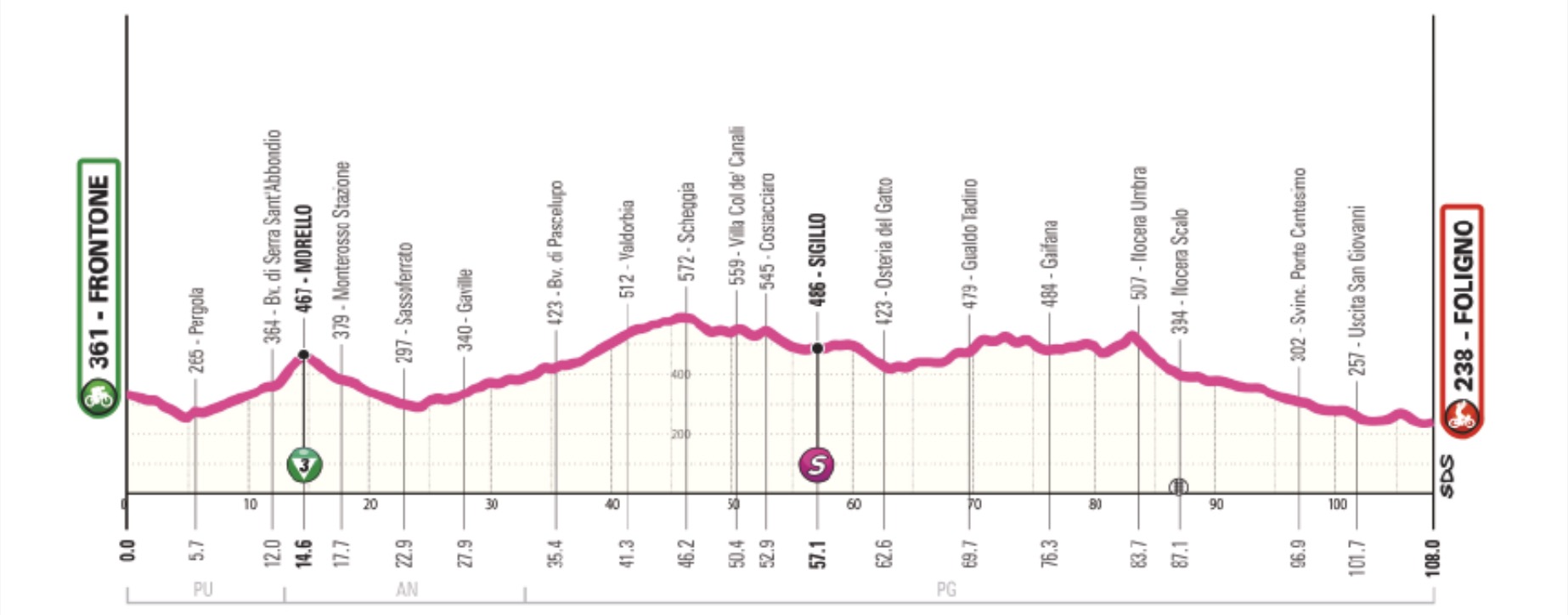
At first glance, this might seem like the easiest day on the program, but caution is advised. The riders will remain in the Apennines, and the route between the start in Frontone and Foligno is never flat. However, the final 25 kilometers are a gradual descent, making for a very fast finish. The city, where the first printed version of Dante’s Divina Commedia came to life, is likely to witness a sprint finish. This is the last chance for the sprinters.
Stage 6
San Benedetto del Tronto – Chieti: 159 km
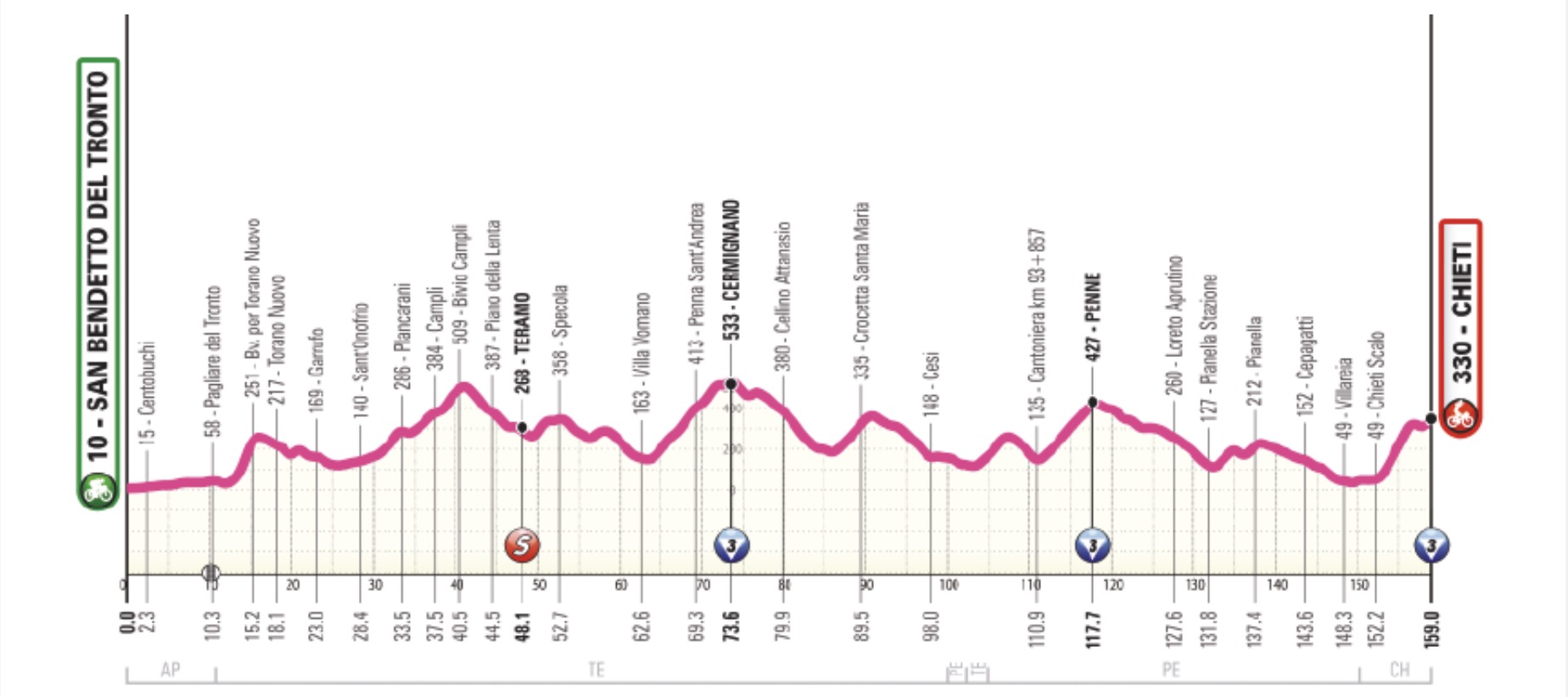
Speaking of ‘divine,’ the sixth stage starts in the coastal town of San Benedetto del Tronto, a popular tourist destination in the Marche region. This day offers the riders no respite. Adventurous riders might try to position themselves favorably on the steep climb to Torano Nuovo, 2.2 kilometers at an average of over 9%, which comes just 13 kilometers into the stage.
After that, it’s a constant up and down. There are ten significant climbs on the map, with points for the mountains classification available in Cermignano, Penne, and at the finish line in Chieti (all third category). The stage features over 2,600 meters of climbing in total, and at 159 kilometers, it is by far the longest stage of this Giro.
Everything points to an impressive stage. Will an early breakaway manage to stay ahead on the final climb of the day? This climb is 3 kilometers at 7.2%, located about three kilometers from the finish, and it will be decisive. Afterward, the road flattens out. Regardless, it is a day for riders with long-range endurance.
Stage 7 👑 👑 👑
Lanciano – Blockhaus: 120 km
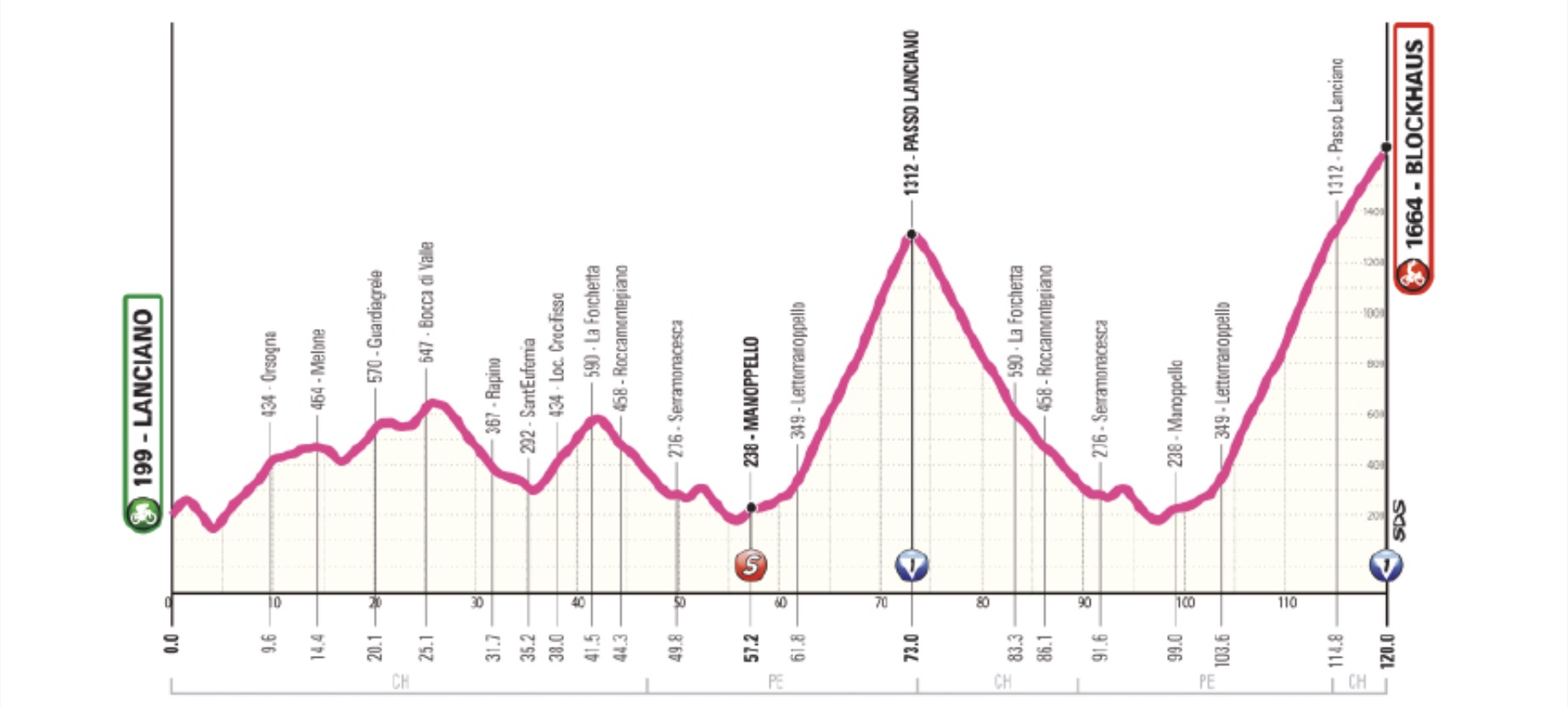
The queen stage of the 2024 Giro d’Italia Women will take place on Saturday, July 13th. The stage starts in Lanciano, a town on the Adriatic Coast known for the first recorded Eucharistic miracle in the eighth century. Perhaps the starting point today will be the foundation of another miracle. After the start, the peloton will head over rolling hills towards one of the highest mountain massifs of the Apennines, the Majella massif.
First up is the Passo Lanciano. This climb has been a finish once in the men’s Giro, where Ivan Basso claimed victory. The climb is over 12 kilometers long with an average gradient of more than 8%. The only advantage is its relative steadiness. However, whatever remains of the peloton after the opening phase will be significantly reduced here.
If the decisive move hasn’t happened on the Passo Lanciano, it will likely occur on the legendary final climb: the Blockhaus. The first twelve kilometers of the climb to Blockhaus will be familiar to the riders as it is the same as the Passo Lanciano. The final treat is another 5.2 kilometers at a gradient of 6.7%, leading to the finish line at 1,664 meters altitude. The Blockhaus has been included in the men’s Giro eight times, always won by a big name, from world champions to multiple Grand Tour winners. Which rider will add her name to this historic list? And will the overall classification be decided today?
Stage 8
Pescara – L’Aquila: 117 km
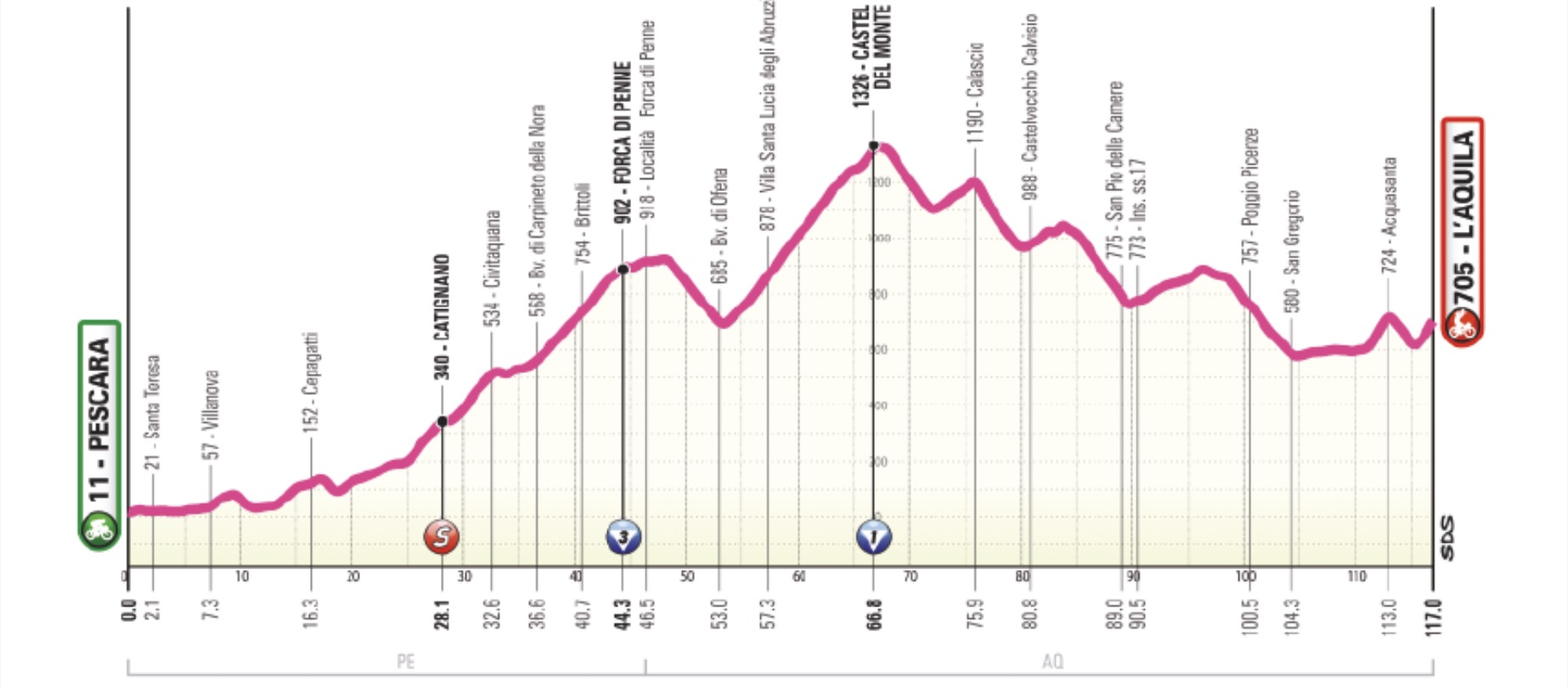
The grand finale of the Giro will be a tough challenge. No parade in a global finish city, no leisurely ride down a boulevard, and no sprint on a famous avenue. The riders will need to race at full throttle today. The bad news for those who have sore legs from the Blockhaus stage is that the toughest part of today’s route is in the first half of the stage.
At the start, the riders will get one last whiff of the Adriatic coast as they set off from Pescara. From there, the roads climb to the Forca di Penne (2nd category), a relatively unknown climb in the Giro. While not particularly steep, averaging just over 3%, it is very long, stretching over 20 kilometers.
This is somewhat similar to the Castel del Monte (1st category). After descending towards Ofena, the road goes directly back up: over 13 kilometers at nearly 5% average. From the summit, 50.2 kilometers from the finish, it descends in stages by 750 meters. Thinking that the riders battling for the stage win will get some rest here is a mistake. The route continues with alternating descents and climbs.
The ultimate finale of the day and the Giro d’Italia Women into L’Aquila is particularly challenging. Four kilometers from the finish, there is a short climb of 1,700 meters at 7.2%, and the last kilometer rises at 7%. It will be a battle all the way to the Villa Comunale in L’Aquila, where the Italian tifosi will welcome the stage winner and the overall champion as only Italian fans can.
Favorites
As tradition dictates, nearly all the big names of the international women’s pro peloton will start the Giro d’Italia Women. The big question is: who will succeed Annemiek van Vleuten? Initially, all eyes turn to Demi Vollering. But, the Dutch rider, who has won every stage race she has participated in this year, is skipping the Giro d’Italia in preparation for the Tour de France and the Olympic Games.
Even without Vollering, Team SD Worx – Protime has a strong contender for the overall victory. None other than world champion Lotte Kopecky will be riding the Giro. The stage to Blockhaus, after last year’s Col du Tourmalet and the early-season Jebel Hafeet, will be a significant test for her.
A major contender is the French rider Juliette Labous. The leader of Team dsm-firmenich has shown excellent form this year with top-five finishes in all her stage races. Labous also recently became the French road champion for the first time, outsmarting a block of FDJ-SUEZ riders.
In addition to Labous, two pairs of riders are worth watching. First, the duo of Elisa Longo Borghini and Gaia Realini from Lidl-Trek. While Longo Borghini seems stronger than ever this year, Realini, after a somewhat disappointing Ardennes trilogy, recently demonstrated a high level of performance again in the Tour de Suisse. The duo will also be supported by a traditionally strong team.
The other pair is Silvia Persico and Erica Magnaldi from UAE Team ADQ. Although it hasn’t been the best year for these two Italian stars, they seem to always perform a bit better in the Giro on home soil.
Another name to always consider is Mavi Garcia. The 40-year-old Spaniard continues to climb with the best and finished just one second behind Labous in the recent Itzulia Women.
For the rest of the competition, it’s a waiting game to see which riders will definitively participate in the Giro. The same goes for the sprinters who will battle it out in the flat stages.
FOLLOW FROM START TO FINISH
You can follow the Giro d’Italia Women from start to finish via our live coverage on the website and in the app!